Circus Maximus › Civilization › Buddhism in Ancient Korea » Origins and History
Articles and Definitions › Contents
- Circus Maximus › Origins
- Civilization › Origins
- Buddhism in Ancient Korea › Origins
Ancient civilizations › Historical places, and their characters
Circus Maximus › Origins
Definition and Origins

The Circus Maximus was a chariot racetrack in Rome first constructed in the 6th century BCE. The Circus was also used for other public events such as the Roman Games and gladiator fights and was last used for chariot races in the 6th century CE.It was partially excavated in the 20th century CE and then remodelled but it continues today as one of the modern city ’s most important public spaces, hosting huge crowds at music concerts and rallies.
EARLY USES
The Circus Maximus, located in the valley between the Palatine and Aventine hills, is the oldest and largest public space in Rome and legend says that the Circus was originally laid out in the 6th century BCE by the first Roman kings, although, it first took on its distinctive shape under Julius Caesar. Its principal function was as a chariot racetrack and host of the Roman Games ( Ludi Romani ) which honoured Jupiter. These were the oldest games in the city and were held every September with 15 days of chariot races and military processions. In addition, Rome had many other games and up to 20 of these had one day or more at the Circus Maximus. Other events hosted at the site included wild animal hunts, public executions and gladiator fights, some of which were exotically spectacular in the extreme, such as when Pompey organised a contest between a group of barbarian gladiators and 20 elephants.
THE OUTSIDE OF THE CIRCUS PRESENTED AN IMPRESSIVE FRONT OF ARCADES IN WHICH SHOPS SERVED THE NEEDS OF THE SPECTATORS.
DIMENSIONS
At its largest during the 1st century CE following its rebuilding after the fire of 64 CE, the Circus had a capacity for 250,000 spectators seated on banks 30 m wide and 28 m high. Seats were in concrete and stone in the lower two tiers and wood for the rest. The seats at the closed curved end date from the early 1st century CE. The outside of the circus presented an impressive front of arcades in which shops would have served the needs of the spectators. The Roman architectural historian Vitruvius also describes a temple of Ceres in the Circus and that it was decorated with terracotta statues or gilt bronze ( On Architecture 3.3.5).
The track, originally covered in sand, measured 540 x 80 m and had 12 starting gates ( carceres ) for chariots arranged in an arc at the open end of the track. A decorated barrier ( spina or euripus ) ran down the centre of the track so that chariots ran in a circuit around conical turning posts ( metae ) placed at each end. The spina also had two obelisks added over the centuries, one in the centre and one at the end. Here also were the lap markers - eggs and dolphins - which were turned to mark the completion of each of the seven circuits of a typical race.

Circus Maximus, Rome
CHARIOT RACES
The chariots themselves were colour-coded (red, white, green and blue) and could be pulled by teams of 4, 6, 8 or 12 horses.Victorious charioteers not only became rich with large cash prizes but they also became the darlings of the crowd, particularly with those who had placed bets, which were sometimes huge. Famous winners were Pontius Epaphroditus, Pompeius Musclosus and Diocles but perhaps the most famous of all, with more than 2,000 race victories, was Scorpus. Horses too became famous and much followed by the knowledgeable crowd. Famed throughout the Roman world, the races at the Circus Maximus were, then, the ones to win as it was by far the most important of the many circuses which dotted the Empire and its status is testified by its many representations in mosaics, relief sculptures and even coins.
The last official chariot race at the Circus Maximus was in 549 CE and was held by Totila, the Ostrogoth king. The site was then largely abandoned, although, the Frangipanni did fortify the site in 1144 CE. The first excavations were carried out under Pope Sixtus V in 1587 CE and the two obelisks which had originally stood as part of the spina were recovered. One dates to c.1280 BCE and was taken by Augustus from Heliopolis in Egypt in 10 BCE. This once stood at the east end of the spina but was relocated to Piazza del Popolo. The second obelisk which had stood in the centre of the spina dates to Thutmosis II (1504-1450 BCE) and was originally made for the temple of Amon at Karnak. Constantine I intended it for Constantinoplebut after remaining at the docks of Alexandria for 25 years, Constantius II brought it to Rome in 357 CE. It now stands in the Piazza S.Giovanni in Laterano (Rome).
LATER USES
The site was used for industry and even a gasworks in the 19th century CE but in the 1930s CE the area was cleared and converted into a park made to resemble the original form of the Circus. Also in 1930, the site was again excavated, a process which continued between 1978 and 1988 CE. Original seats were revealed, as were the starting gates and the spina.However, the latter two were re-covered and now lie some 9 m under the present ground level. The curved seat end continues to be excavated today whilst the main part of the circus is still used for large public events such as concerts and rallies.
Civilization › Origins
Definition and Origins

The meaning of the term civilization has changed several times during its history, and even today it is used in several ways. It is commonly used to describe human societies "with a high level of cultural and technological development", as opposed to what many consider to be less "advanced" societies. This definition, however, is unclear, subjective, and it carries with it assumptions no longer accepted by modern scholarship on how human societies have changed during their long past.
Etymologically, the word civilization relates to the Latin term civitas, or ” city ”, which is why it sometimes refers to urban state-level societies, setting aside the nomadic people who lack a permanent settlement and those who live in settlements that are not considered urban or do not have a state-level organization. Sometimes it can be used as a label for human societies which have attained a specific degree of complexity. In a wide sense, civilization often means nearly the same thing as culture or even regional traditions including one or more separate states. In this sense, we sometimes speak of the “ Aegeancivilization”, “Chinese civilization”, “Egyptian civilization”, or “Mesoamerican civilization”, but each of these may include several cities or regions, for example: “Mesoamerican civilization” includes groups such as the Olmec, Maya, Zapotec, Aztec, and others; “Aegean civilization” includes the Minoan, Mycenaean, and other societies of the Cycladic islands and western Anatolia.
A BEHAVIOUR CONSIDERED "CIVILIZED"BY A PARTICULAR CULTURE MAY BE JUDGED SENSELESS OR EVEN SEEN WITH HORROR BY ANOTHER CULTURE.
DEVELOPMENT OF THE TERM “CIVILIZATION”
During the late 19th and early 20th centuries CE, it was widely believed among European scholars that all human communities were involved in a process of straightforward progression by which the conditions of a society were gradually improving. As part of these changes, it was believed, societies experienced different stages: savagery, barbarism and, finally, civilization.Civilization, in this context, was understood as the last stop in the long journey of human society. The different stages of this social evolution were equated to specific human communities: Palaeolithic and Mesolithic hunter-gatherer communities were considered part of the savagery stage, Neolithic and Bronze Age farmers as part of the barbarism stage, and finally Bronze Age urban communities (particularly those in the Near East ) were considered an early phase of the civilized world. Today, this approach is no longer valid since it is linked to an attitude of cultural superiority, by which human communities which are not yet "civilized" are seen as somehow inferior.
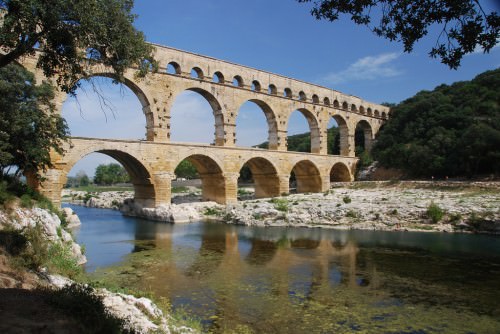
Pont Du Gard Aqueduct
ETHNOCENTRIC VIEWS
In everyday conversation, there is a tendency to use the word "civilization" to refer to a type of society that displays a set of moral values, such as respect for human rights or a compassionate attitude for the sick and the elderly. This can be problematic, since moral values are inevitably one-sided and ethnocentric. A behaviour considered "civilized" by a particular culture may be judged senseless or even seen with horror by another culture. History records an abundant number of examples of this issue. A famous one is reported by Herodotus, who describes the conflicting funerary practices of a group of Greeks, who cremated their dead, and the Indians known as the Kallatiai, who ate their dead:
During his reign, Darius summoned the Hellenes at his court and asked them how much money they would accept for eating the bodies of their dead fathers. They answered that they would not do that for any amount of money. Later Darius summoned some Indians called Kallatiai, who do eat their parents. [...], he [Darius] asked the Indians how much money they would accept to burn the bodies of their dead fathers. They responded with an outcry, ordering him to shut his mouth lest he offended the gods. Well, then, that is how people think, and so it seems to me that Pindar was right when he said in his poetry that custom is king of all (Herodotus 3.38.3-4).

Mask of Xiuhtecuhtli
ATTRIBUTES OF A CIVILIZATION
An influential scholar named Gordon Childe identified a list of ten attributes that distinguish a civilization from other kind of societies; his list was reviewed and rewritten many times. What follows is the version of Charles Redman, an American archaeologist:
Primary characteristics
1. Urban settlements
2. Full-time specialists not involved in agricultural activities
3. Concentration of surplus production
4. Class structure
5. State-level organization (government)
2. Full-time specialists not involved in agricultural activities
3. Concentration of surplus production
4. Class structure
5. State-level organization (government)
Secondary characteristics
6. Monumental public building
7. Extensive trading networks
8. Standardized monumental artwork
9. Writing
10. Development of exact sciences
7. Extensive trading networks
8. Standardized monumental artwork
9. Writing
10. Development of exact sciences
Today it is acknowledged that these criteria can be problematic for a number of reasons, mainly because the archaeological criteria used to define a civilization are not always clear-cut: reality is indifferent to our intellectual distinctions. We know of complex civilizations, like the Incas, who did not have a writing system; we know of societies which produced monumental buildings, like in the Eastern Islands or Stonehenge, where neither state-level organization nor writing existed; and we even know urban centres, like the Preceramic Civilization in the Andes (c. 3000-1800 BCE) long before the time of the Incas, which were established before the development of extensive agriculture.
This list, however, offers a framework by which the attributes of any society can be objectively compared. If a society displays most of these attributes (or even all of them), it will enable us to refer to it as a civilization no matter how alien, unpleasant, or archaic we might find its way of life and values.
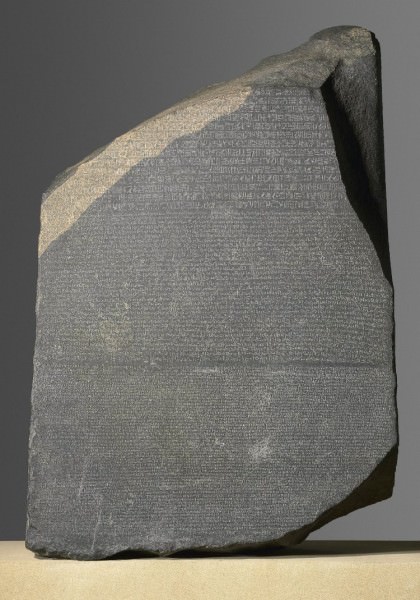
Rosetta Stone
Up until 1970's CE, the explanations accounting for how civilizations developed tended to be monocausal, and civilizations were considered an inevitable end product of social or political evolution. Today, it is acknowledged that multi-causal explanations are likely to better explain the development of civilizations: we know that many of the social forces that in the past were believed to inevitably lead to the development of cities and states (such as long distance trade, irrigation systems, or population increase) do not always lead to that result. The diversity of human experience seems too complex and vast for our concepts to fit reality perfectly. It might be wiser, and perhaps closer to the truth, to realize that each human society is shaped by its own unique set of circumstances, and that universal explanations or general concepts do not always make perfect sense. Only if we keep these limitations in mind, the concept of civilization gains strength and becomes a useful conceptual tool.
Buddhism in Ancient Korea › Origins
Ancient Civilizations
Buddhism, in Korean Pulgyo, was introduced by monks who visited and studied in China and then brought back various Buddhist sects during the Three Kingdoms period. It became the official state religion in all Three Kingdoms and subsequent dynasties, with monks often holding important advisory roles in governments. Korean Buddhism came to be much more inclusive than in other cultures with significant attempts made by important Buddhist scholars to reconcile the many diverging branches of the religion. Buddhism would have a profound influence on Korean art, literature, and architecture from bells to pagodas, ceramics, sculpture, and even developments in printing techniques.
INTRODUCTION FROM CHINA
According to tradition, Buddhism was introduced first to the kingdom of Goguryeo ( Koguryo ) in 372 CE, followed by Baekje( Paekche ) in 384 CE, and finally in the Silla kingdom between 527 and 535 CE. The first monk to bring Buddhist teachings was Sundo, who was sent for that purpose by the ruler of Eastern Qin, Fu Jian. It was hoped that stronger cultural ties with Goguryeo would lead to more practical cooperation in meeting the military threat posed by hostile Manchurian tribes. A decade later, Marananta, an Indian or Serindian monk, came from the Eastern Jin state and taught Buddhism in the Baekje kingdom.In both states, the new faith received a favourable reception. In the Silla kingdom, though, Buddhism was seen as a threat to the traditional religions of shamanism, animism, and ancestor worship, and not until the martyrdom of the monk Ichadon was Buddhism finally accepted and then promoted by the royal court.
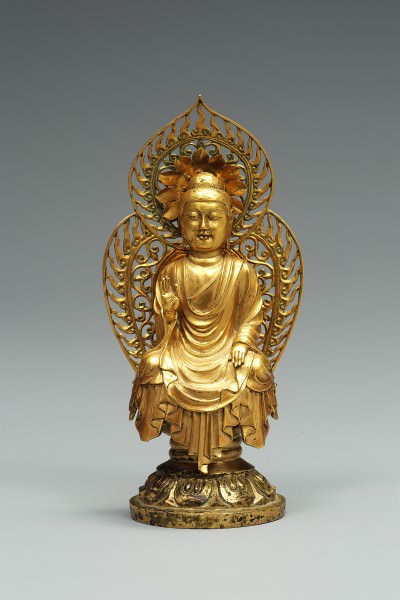
Unified Silla Kingdom Gold Buddha
POLITICAL ENDORSEMENT
The Korean states likely adopted Buddhism and other aspects of Chinese culture as a way to ingratiate themselves with their powerful neighbour. Still in their infancy, the Three Kingdoms faced incursions from Manchurian tribes, each other, and the latent threat of further Chinese expansion into the peninsula when they already held commanderies in the north. Korea, naturally, had its own indigenous culture and typically added its own stamp of identity to those influences which came from abroad, but nevertheless, ideas on religion, government, court rituals, language, tomb architecture, ceramic production, sculpture, coinage, and classic literature all came from China. Korean states, in their turn, would spread Buddhism, and some of these other features of culture, to Japan. Korean monks would also continue to travel to China in the following centuries in order to acquire new knowledge, texts, and discover new branches of the religion.
There were other advantages for Korean rulers to promote Buddhism besides keeping good relations with China. As most monks came from the aristocracy, the religion became an endorsement of the status quo and gave rulers a certain prestige of association. Many monks became advisors to monarchs over the centuries, giving governments extra authority in the eyes of the people. As the historian Jinwung Kim summarises,
The Buddhist teaching of an endless cycle of reincarnation, a rebirth based on karma, retribution for the deeds of a former life, justified strict social stratification. Buddhism was a doctrine that justified the privileged position of the establishment, and for this reason, it was adamantly welcomed by the king, the royal house, and the aristocracy. (67)
The appeal of Buddhism for the poor was the message that the suffering of this life could be avoided in the next one but the positions of authority within it were largely reserved for the well-educated scholars who had the time and means to pursue enlightenment. In the Silla kingdom, aristocratic youths were trained in the Hwarang or 'Flower Boys' system, which despite its Buddhist teachings, emphasised martial prowess and heroism. During the Goryeo dynasty, there were also entrance examinations for monks based on sacred texts, further limiting access by the under-privileged.
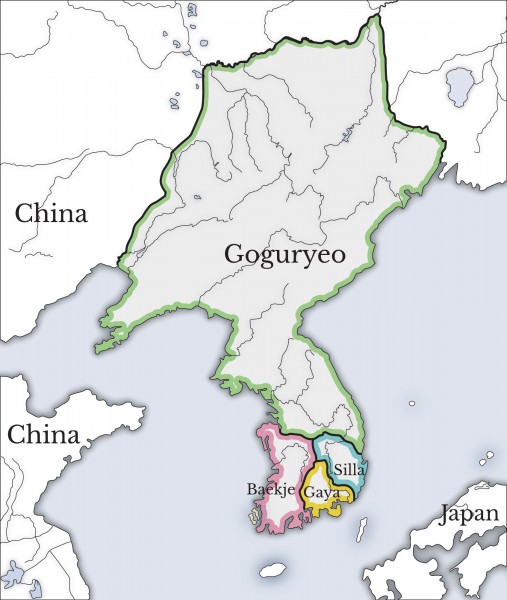
Three Kingdoms of Korea
Buddhism, although the state religion, existed side-by-side with the other three main religions practised in Korea: Confucianism, Shamanism, and Taoism. Confucianism was largely observed in the realm of government, but the others remained popular with the lower classes, and there was also much borrowing of iconography in the arts with Buddhist paintings incorporating shamanistic elements and gods, and vice-versa. However, Buddhism, with its state-backing, was made ever more popular, especially by the rulers of the Goryeo dynasty, starting with their founder Wang Geon (aka Taejo, r. 918-943 CE) who credited his success in defeating Goryeo's enemies to his faith in Buddhism:
The success of the great enterprise of founding our dynasty is entirely owing to the protective powers of the many Buddhas. We must therefore build temples for both Son and Kyo Schools and appoint abbots to them, that they may perform the proper ceremonies and themselves cultivate the way. (Portal, 81)
Once established as the official state religion, Buddhist temples and monasteries sprang up across Korea, and these, with their landed estates, royal patronage, and exemption from tax, became so wealthy that the whole religious apparatus rivalled that of the state itself. Many such monasteries even had their own armed forces recruited from warrior-monks and the general populace. It is also true that such institutions helped the poor by offering regular feasts and accommodation to those in dire straits.
THE FAITHFUL WOULD RECITE SUTRAS, LIGHT INCENSE STICKS, & WALK AROUND THE PAGODA OF A TEMPLE.
RITES, RITUALS & FESTIVALS
Buddhist temples may have one, three, or five main halls and these house statues (or sometimes just paintings) of Buddha or Bodhisattvas (beings which refrain from joining nirvana in order to assist the living) which receive worship, prayers, and dedications from devotees. The faithful would recite sutras (the sermons of Buddha), light incense sticks, and walk around the pagoda of a temple. Such rites tend to be performed by the individual rather than congregations of believers. Important festivals in the calendar, when group activities did occur, included the Buddha's birthday ( chopail ) when worshippers visited temples in lantern-lit processions while chanting mantras and hung paper lanterns in their homes and in the streets. Another major festival was Palgwanhoe or the 'Eight Vows Festival' which commemorates departed spirits and was linked to the harvest in farming communities.
DEVELOPMENTS IN KOREAN BUDDHISM
As Buddhism evolved in China with the creation of various sects, so too in Korea the faith branched out, either from direct imitation via travelling monks such as Pomnang who brought back Son (Zen) Buddhism in the first half of the 7th century CE, or through Korea's own adaptation. The monk Uicheon (1055-1101 CE) famously attempted but ultimately failed to bridge the gap between the two major branches of Buddhism – the Son and Kyo sects, which stressed the importance of meditation and scriptures respectively. Chinul (1158-1210 CE) was more successful in this endeavour, epitomised by his famous maxim: 'sudden enlightenment followed by gradual cultivation.' Chinul's unifying and inclusive form of Buddhism is known as Chogye Buddhism, and it became the official state religion of Korea with its centre at the Sonnqqwangsa temple near modern-day Sunchon. From the 15th century CE, Buddhism would be replaced in importance by the rise of Neo-Confucianism, at least in terms of state endorsement. Chogye Buddhism continues today in South Korea to be the most popular form of Buddhism.
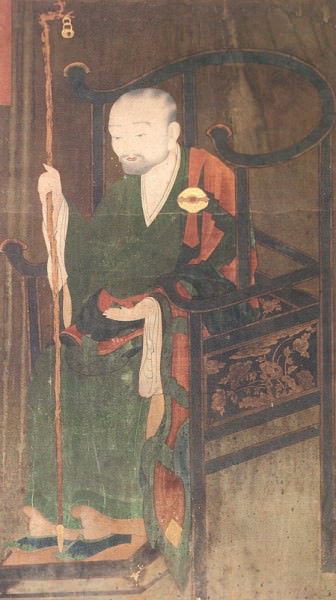
Chinul
BUDDHIST ART
Buddhism in Goryeo Korea was directly responsible for the development of printing for it was to spread Buddhist literature that woodblock printing improved and then movable metal type was invented in 1234 CE. Indeed, the entire corpus of Buddhist texts, the Tripitaka, was printed in 1251 CE using over 80,000 woodblocks, partly in the belief that this would help protect Korea from Khitan invasions. Another Buddhist contribution to the arts is illuminated manuscripts. These sagyong are usually of texts from the sutras (sermons) attributed to Buddha and formed scrolls and folded books. They were written by monk-scribes on indigo hanji paper using bright dyes and sometimes even silver and gold. Buddhist monks also painted frescoes and silk wall hangings to decorate temples, with bodhisattvas and water-flowers being the most popular subjects.
THE ENTIRE CORPUS OF BUDDHIST TEXTS, THE TRIPITAKA, WAS PRINTED IN 1251 CE USING OVER 80,000 WOODBLOCKS.
Stone and gilt-bronze sculptures were produced, especially of the Buddha, bodhisattvas, and the future Buddha, Maitreya.Figures of Buddha as Maitreya (the coming Buddha) were popular and some are massive such as the 17.4 metre (57 ft.) high one at Paju and the 18.4 metre (59.3 ft.) tall figure at the Kwanchok temple in Nonsan which were both carved out of natural boulders in the 11th century CE. Another area of metalwork was the production of bells for Buddhist temples in both the Unified Silla and subsequent Goryeo kingdom. These and pottery used Buddhist motifs such as the lotus flower, cranes, and clouds. Finally, Buddhism was an important subject in hyangga, the poetical 'country songs,' which were written in the Silla and Goryeo kingdoms.
BUDDHIST ARCHITECTURE
Buddhist temples were built in great numbers across the peninsula, but the 7th-century CE Miruk temple at Iksan (now lost) is worth special mention. Built by the Baekje king Mu, it was the largest Buddhist temple in East Asia and had two stone pagodas and one in wood. One stone pagoda survives, albeit with only six of its original 7-9 storeys. The only other surviving Baekje pagoda is also of stone and located at the Chongnim temple at Puyo. Stone pagodas are Korea's unique contribution to Buddhist architecture (in Japan they are of wood and in China of brick).
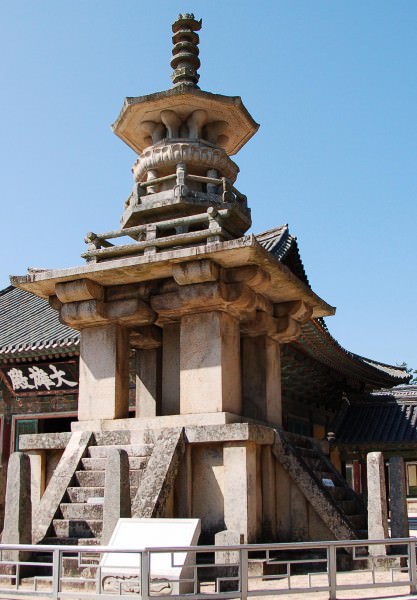
Dabotap Pagoda, Gyeongju
Notable surviving Buddhist structures at Gyeongju, the Silla capital, include two more surviving stone pagodas – the Dabotap and Seokgatap – which both date to the 8th century CE, traditionally 751 CE. This pair were originally part of the magnificent 8th-century CE Bulguksa temple ('Temple of the Buddha Land'), which now stands restored but only a fraction of its original size. The complex, as its name suggests, was designed to represent the Land of Buddha, that is paradise. For this reason, there are three principal zones: Birojeon (Vairocana Buddha Hall), Daeungjeon (Hall of Great Enlightenment and main temple), and Geungnakjeon (Hall of Supreme Bliss). This architectural representation of paradise, which rises symmetrically from a lotus lake, is symbolically entered via two stone bridges and a large staircase, reminding the visitor that they are leaving the earthly realm behind them and stepping into the sacred realm of Buddha.
One of the outstanding Buddhist structures from the Unified Silla period is the Buddhist cave temple at Seokguram (Sokkuram) east of Gyeongju. Constructed between 751 and 774 CE, it contains a circular domed inner chamber within which is a massive 3.45-metre-high seated Buddha. The walls are decorated with 41 large figure sculptures of disciples and bodhisattvas.
A good idea of the architectural style prevalent during the later Goryeo dynasty (918-1392 CE) is seen in the 13th-century CE Hall of Eternal Life (Muryangsujeon) at the Pusok temple in Yongju. It is one of the oldest wooden structures surviving in the whole of Korea.
This article was made possible with generous support from the British Korean Society.
LICENSE
Article based on information obtained from these sources:with permission from the Website Ancient History Encyclopedia
Content is available under License Creative Commons: Attribution-NonCommercial-ShareAlike 3.0 Unported. CC-BY-NC-SA License